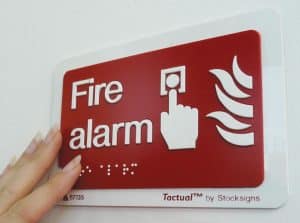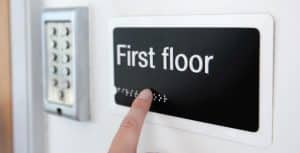At Stocksigns we supply Braille signs to make buildings safe for all visually impaired people. This range includes fire safety, prohibition and information signage, all of which are available in photoluminescent.
As part of the Disability Discrimination Act (DDA), service providers must ensure that access is available to all disabled people and that entry routes, facilities and all information are clearly defined and indicated by suitable signage.
Our signs use an innovative and visually superior tactile signage system. It is capable of conveying fast, effective information to alert the visually impaired. Our signage uses:
- Wide space, raised supplementary text
- Highly durable and accurate grade 1 braille
- Braille locator
- Low gloss surface with a high contrast colour range
- All safety symbols conform to BS EN ISO 7010
To discuss your braille requirements call a member of our experienced sales team now on 01737 774072. Alternatively you can send us an email:
Click here to email the sales team


